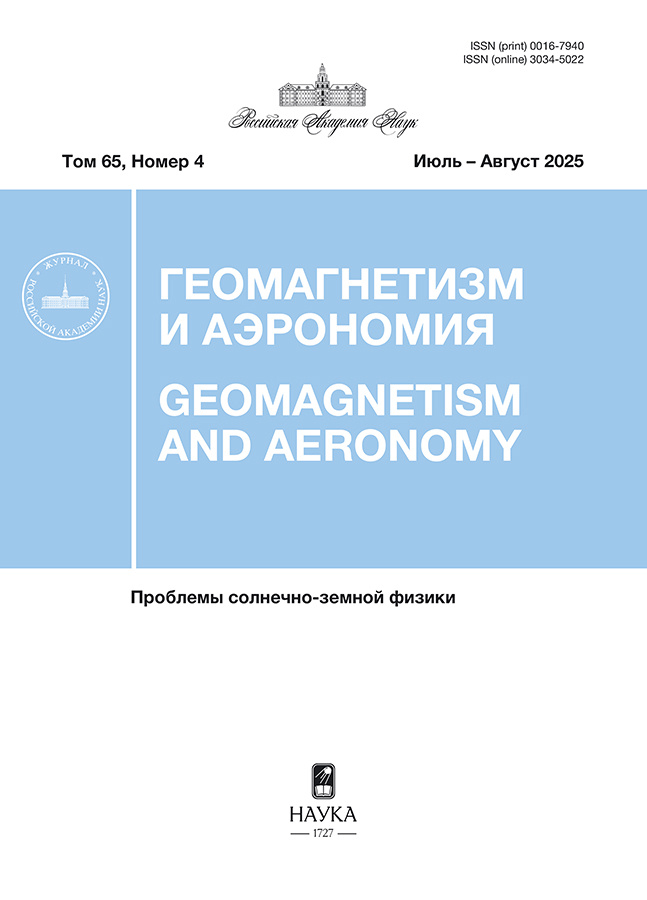Автокорреляции фрагментов цикла чисел Вольфа и прогноз на полцикла солнечной активности
- Авторы: Яковлева С.В.1, Старченко С.В.1
-
Учреждения:
- Институт земного магнетизма, ионосферы и распространения радиоволн им. Н.В. Пушкова РАН
- Выпуск: Том 64, № 6 (2024)
- Страницы: 727-736
- Раздел: Статьи
- URL: https://transsyst.ru/0016-7940/article/view/681545
- DOI: https://doi.org/10.31857/S0016794024060013
- EDN: https://elibrary.ru/QOZFMT
- ID: 681545
Цитировать
Полный текст
Аннотация
Рассмотрены автокорреляции фрагментов ряда чисел Вольфа (версия V2) с целью прогнозирования на 6 лет (полцикла солнечной активности). Из физических и оптимальных соображений использовались фрагменты, подобные полутора циклам. Тестирование успешно осуществлялось на достаточно надежных парах фрагментов ряда, состоящих из фиксированного и сдвигаемого по времени фрагмента. Для тестирования выбиралась пара, если коэффициент корреляции при совмещении составляющих ее частей был 0.91 и более. Использовалась оригинальная модификация фиксированного фрагмента и следующих за ним участков ряда. Аналогичным образом сделаны прогнозы на 6 лет после 2023 г., исходящие из фрагмента (2008.5−2023.5), имеющего коэффициенты корреляция от 0.81 до 0.96 с фрагментами (1978.5−1993.5), (1901.5−1916.5), (1922.5−1937.5), (1964.5−1979.5), (1985.5−2000.5). Максимальное значение числа Вольфа (161 ± 30) ожидается в середине 2024 г.
Ключевые слова
Полный текст
Об авторах
С. В. Яковлева
Институт земного магнетизма, ионосферы и распространения радиоволн им. Н.В. Пушкова РАН
Автор, ответственный за переписку.
Email: svyakov@inbox.ru
Россия, Троицк
С. В. Старченко
Институт земного магнетизма, ионосферы и распространения радиоволн им. Н.В. Пушкова РАН
Email: sstarchenko@mail.ru
Россия, Троицк
Список литературы
- Бондарь Т.Н., Ротанова Н.М., Обридко В.Н. Прогнозирование временного ряда чисел Вольфа для 23-го солнечного цикла // Письма в Aстрон. журн. Т. 22. № 8. С. 628−630. 1996.
- Витинский Ю.И. Цикличность и прогнозы солнечной активности. Л.: Наука, 258 c. 1973.
- Ишков В.Н. Периоды “пониженной” и “повышенной” солнечной активности: наблюдательные особенности и ключевые факты / Сб. “Солнечная и солнечно-земная физика – 2013”. Ред. А.В. Степанов и Ю.А. Наговицын. СПб.: Изд. ВВМ. С. 111−114. 2013.
- Ишков В.Н., Шибаев И.Г. Циклы солнечной активности: общие характеристики и современные границы прогнозирования // Изв. РАН. Сер. физическая. Т. 70. № 10. С.1439–1442. 2006.
- Гневышев М.Н., Оль А.И. О 22-летнем цикле солнечной активности // Астрон. журн. Т. 25. № 1. С. 18−20. 1948.
- Наговицын Ю.А., Огурцов М.Г. Грандиозные минимумы и максимумы солнечной активности и климата Земли: последнее тысячелетие и картина будущего “в общих чертах” / Тр. 7-й Международной Пулковской конференции “Климатические и экологические аспекты солнечной активности”. Пулково, 7-11 июля 2003 г. СПб.: ГАО РАН. С. 321−326. 2003.
- Обридко В. Н., Наговицын Ю. А. Солнечная активность, цикличность и методы прогноза. СПб.: Изд. ВВМ, 466 c. 2017.
- Обридко В.Н., Шельтинг Б.Д. Об отрицательной корреляции между солнечной активностью и скоростью вращения Солнца // Письма в Aстрон. журн. Т. 42. № 9. С. 694–700. 2016. https://doi.org/10.7868/S0320010816080040
- Ожередов В.А., Бреус Т.К., Обридко В.Н. Прогнозирование полного 24-го цикла солнечной активности несколькими вариантами авторегрессии и методом предвестника // Геофизические процессы и биосфера. Т. 10. № 3. С. 51−65. 2011.
- Старченко С.В., Яковлева С.В. Корреляция временных рядов чисел Вольфа и их производных // Геомагнетизм и аэрономия. Т. 62. № 2. С. 144−154. 2022. https://doi.org/10.31857/S001679402202016X
- Abdel-Rahman H.I., Marzouk B.A. Statistical method to predict the sunspots number // NRIAG Journal of Astronomy and Geophysics. V. 7. N 2. P. 175−179. 2018. https://doi.org/10.1016/j.nrjag.2018.08.001
- Abdusamatov K.I. Optimal prediction of the peak of the next 11-year activity cycle and of the peaks of several succeeding cycles on the basis of long-term variations in the solar radius or solar constant // Kinemat. Phys. Celest. V. 23. N 3. P. 97–100. 2007. https://doi.org/10.3103/S0884591307030026
- Brajša R., Verbanac G., Bandić M., Hanslmeier A., Skokić I., Sudar D. A prediction for the 25th solar cycle maximum amplitude // Astron. Nachr. V. 343. N 3. ID e13960. 2022. https://doi.org/10.1002/asna.202113960
- Dmitrieva I.V., Kuzanyan K.M., Obridko V.N. Amplitude and period of the dynamo wave and prediction of the solar cycle // Sol. Phys. V.195. N 1. P. 209–218. 2000. https://doi.org/10.1023/A:1005207828577
- Hathaway D.H. The solar cycle // Living Rev. Sol. Phys. V. 12. N 1. ID 4. 2015. https://doi.org/10.1007/lrsp-2015-4
- Hathaway D.H., Wilson R.M. Geomagnetic activity indicates large amplitude for sunspot cycle 24 // Geophys. Res. Lett. V. 33. N 18 ID L18101. 2006. https://doi.org/10.1029/2006GL027053
- Hathaway D.H., Wilson R.M., Reichmann E.J. A synthesis of solar cycle prediction techniques // J. Geophys. Res. – Space. V. 104. N. 10. P. 22375–22388. 1999. https://doi.org/10.1029/1999JA900313
- Leamon R.J., McIntosh S.W., Chapman S.C., Watkins N.W. Response to “Limitations in the Hilbert transform approach to locating solar cycle terminators” by R. Booth // Sol. Phys. V. 296. N 10. ID 151. 2021. https://doi.org/10.1007/s11207-021-01897-z
- McIntosh S.W., Chapman S., Leamon R.J., Egeland R., Watkins N.W. Overlapping magnetic activity cycles and the sunspot number: Forecasting sunspot cycle 25 amplitude // Sol. Phys. V. 295. N 12. ID 163. 2020. https://doi.org/10.1007/s11207-020-01723-y
- Nagovitsyn Y.A., Ivanov V.G. Solar сycle рairing and рrediction of сycle 25 // Sol. Phys. V. 298. N 3. ID 37. 2023. https://doi.org/10.1007/s11207-023-02121-w
- Nandy D. Progress in solar cycle predictions: Sunspot cycles 24–25 in perspective // Sol. Phys. V. 296. N 3. ID 54. 2021. https://doi.org/10.1007/s11207-021-01797-2
- Pesnell W.D. Solar cycle predictions (invited review) // Sol. Phys. V. 281. N 1. P. 507–532. 2012. https://doi.org/10.1007/s11207-012-9997-5
- Petrovay K. Solar cycle prediction // Living Rev. Sol. Phys. V. 17. N 1. ID 2. 2020. https://doi.org/10.1007/s41116-020-0022-z
- Pishkalo M.I. Preliminary рrediction of solar cycles 24 and 25 dased on the correlation between сycle рarameters // Kinemat. Phys. Celest. V. 24. N 5. P. 242–247. 2008. https://doi.org/10.3103/S0884591308050036
- Zhu H., Zhu W., He M. Solar cycle 25 prediction using an optimized long short-term memory mode with F10.7 // Sol. Phys. V. 297. N 12. ID 157. 2022. https://doi.org/10.1007/s11207-022-02091-5
Дополнительные файлы
















